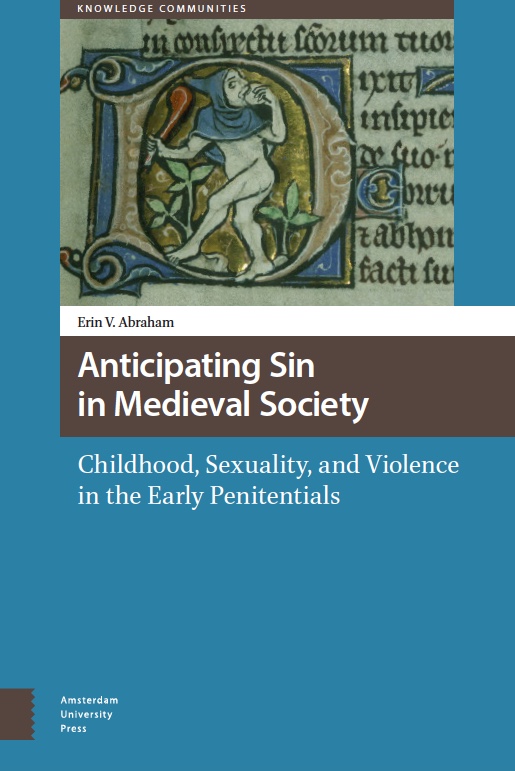Erin Abraham
Anticipating Sin in Medieval Society explores early medieval understandings of childhood, sexuality and violence. Drawing on a number of penitentials (little books of penance) which were composed between the sixth and ninth centuries, and placing sins in their social context, it demonstrates how authors and audiences understood a variety of social phenomena. It thus uncovers some of the less tangible aspects of early medieval history, including the innocence and vulnerability of young children and the relationship between speech and culpability; the links between puberty, autonomy, and moral accountability; early medieval efforts to regulate sexual relationships; and much more.

NOTCHES: In a few sentences, what is your book about?
Abraham: In very general terms, the book focuses on the intersections of the social and the spiritual as they emerge in early medieval penitentials, and the ways those concepts relate to ideas in other contemporary sources. More specifically, I use these little books of penance for clues into discourses about the subjectivity of culpability, according to factors such as age, knowledge, sex, and status, as well as the circumstances surrounding potential transgressions, from minor thefts to homicide.
NOTCHES: Your main sources for this book are penitentials. What are penitentials, and why are they useful historical sources? Do they have any drawbacks?
Abraham: The early penitentials are small manuals, created roughly between the sixth and ninth century, which set out appropriate scales of penance for a variety of potential transgressions. They are useful in part because of the range of issues they address, and the scope of circumstances they consider. Perhaps more importantly, though, is what they reveal about the perceived links between social and spiritual concerns.
They do present a number of complications. Antagonisms towards the penitentials led to calls for their destruction, and this, combined with the passage of time, means that the originals of many have been lost. There are also uncertainties about how or if they were actually used for their stated purposes. For the book, I decided to take their claims at face value: while they may not have been widely used in pastoral settings, their authors repeatedly insist that their objective is to “cure the sounds of sin,” and for the purposes of my book, this intent is more important than if those intentions were realized.
They also present some challenges in the terminology that they employ to distinguish between certain sins, especially sexual sins. Further, as prescriptive texts, the penitentials are limited in what they can tell us about actual behaviours, but they do clarify what their authors thought were likely issues to arise in a social arena and the penances they suggest provide some indications about how sins were thought to affect communities.
NOTCHES: Why was the medieval church so interested in sex, and what sexual ideal was it trying to promote?
Abraham: There is no simple answer to explain the medieval church’s interest in regulating the sexual lives of its members. At its core, however, that concern centered on the spiritual implications of sexual intercourse and desire, for individuals and the wider community. The sexual ideal that it sought to promote was one in which sexual intercourse was limited to heterosexual couples whose marriages were deemed legitimate by the church, and with the goal of procreating. Accordingly, the penitentials (alongside other voices from the period) sought to curtail sexual relationships and acts that deviated from that ideal.
NOTCHES: What sexual behaviours are discussed in these texts, and how were they punished?
Abraham: The discussions vary from penitential to penitential, but as a whole, these manuals address a comprehensive range of sexual behaviours: autoeroticism, sexual dreams, marital sexual regulations, clerical marriage and celibacy, extramarital heterosexual infidelity, homosexual relationships, and specific sex acts, with most attention on same-sex interactions between males, distinguished by manner of stimulation (mutual masturbation, oral sex, interfemoral stimulation, and anal sex). Several of the penitentials also present penances for what they refer to as the “sin of Sodom,” a less-than-candid phasing that, in its historical context, implies connotations of luxuria beyond simple penetrative sex acts.
NOTCHES: Do the penitentials reveal any concerns or attitudes which we might find surprising?
Abraham: For myself, the most unexpected attitude was an underlying expectation that people are fallible but also redeemable, along with the sentiments that the authors express about how important it is for confessors to interact with careful consideration of the individual(s) involved. In part, this was a surprise because the penitentials are frequently described as tariffs of sin and penance, which ignores the subjective process they all advocate.
NOTCHES: Were all Christians treated the same, or were there differences in the church’s approach to men and women, children and adults, priests and laypeople?
Abraham: In terms of penance, the penitentials insist that sins be assessed in relation to the age, understanding, sex, and status of the individual sinner. Some also advise confessors to consider the emotional context of a transgression. Children appear as potential penitents, but the suggested penances are of much shorter duration than those suggested for adults who have committed the same sin. Members of the clergy, in contrast, are subject to much harsher penances than their lay counterparts for most transgressions. The sex of the penitent is also important, but often less visible as a relative factor except in censures of sexual behaviour, where the sex of the penitent is often inseparable from the specific transgression under consideration.
NOTCHES: How did you become interested in the history of sexuality, and what drew you this topic?
Abraham: I am most interested in the social history of the early middle ages, and sex and sexuality are integral parts of that history, although not always treated as such. I stumbled upon the penitentials by accident and was struck by what seemed, at first, to be their frank discussion of sexuality. While they do devote a lot of space to censures of sex overall, many of their discussions are actually less candid than they appear. Looking further into the underlying issues, deciphering the historical context of the vocabulary they use, and considering them in relation to other discourses helps clarify the way a sexual ethos operates in (and sometimes in opposition to) the wider social environment.
NOTCHES: This book is clearly about the history of sex and sexuality, but what other themes does in speak to?
Abraham: The book also discusses perceptions of innocence and vulnerability in relation to childhood, related notions of the transitions from childhood to adulthood involving greater culpability and autonomy dependent in large part on gender, and the social and spiritual consequences of violence. It also speaks to the place of the penitentials within broader discourses and the weakness of imposed binaries, such as crime/sin and social/spiritual, in our understanding of the past.
NOTCHES: People often feel that medieval history doesn’t have much relevance today- but do you feel that this book speaks to any contemporary issues?
Abraham: Absolutely. The penitentials’ discussions of childhood vulnerability and relative culpability is particularly relevant for enduring discussions about the same issues, especially as they relate to laws and policies regarding the charging and incarceration of children.
NOTCHES: What are you working on now that your book is published?
Abraham: Much of my energy is currently directed towards teaching and being involved in my program’s transition into a college, but I have also started exploring the penitentials as sources for the history of emotion. These manuals have so much to say, despite being relatively brief, and their treatments of emotions are largely underrepresented in current research.
 Erin Abraham is a Visiting Assistant Professor at the University of Wyoming, where she teaches in the Honors College and serves as faculty mentor for students completing their Senior Honors Theses. She received her PhD from Saint Louis University in Medieval and Early Modern History in 2011. Her research interests focus on early medieval penitentials as sources for social histories of sex and sexuality, childhood, violence, penance, and emotion. In addition to a number of papers about those subjects, she is the author of Anticipating Sin in Medieval Society: Childhood, Sexuality, and Violence in the Early Penitentials.
Erin Abraham is a Visiting Assistant Professor at the University of Wyoming, where she teaches in the Honors College and serves as faculty mentor for students completing their Senior Honors Theses. She received her PhD from Saint Louis University in Medieval and Early Modern History in 2011. Her research interests focus on early medieval penitentials as sources for social histories of sex and sexuality, childhood, violence, penance, and emotion. In addition to a number of papers about those subjects, she is the author of Anticipating Sin in Medieval Society: Childhood, Sexuality, and Violence in the Early Penitentials.

NOTCHES: (re)marks on the history of sexuality is licensed under a Creative Commons Attribution-NonCommercial-NoDerivatives 4.0 International License.
Based on a work at www.notchesblog.com.
For permission to publish any NOTCHES post in whole or in part please contact the editors at NotchesBlog@gmail.com





i wish I could afford every book this blog interviews… and had time to read them all! Thank you and fascinating.